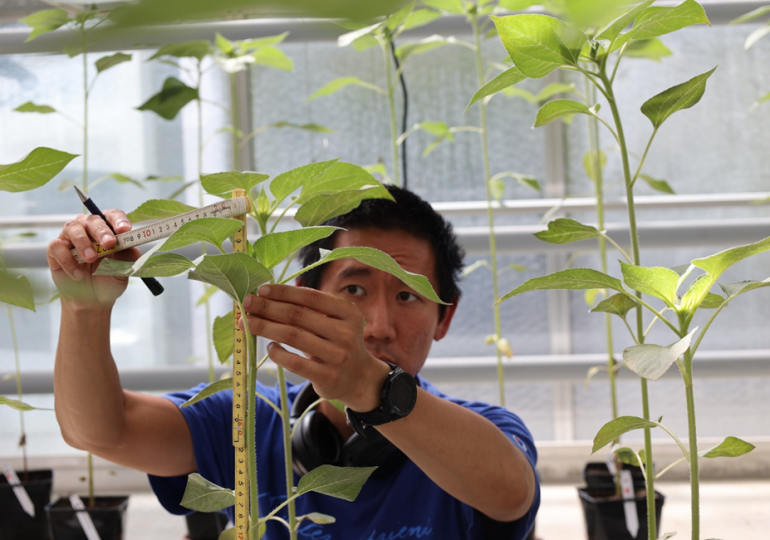In this new post Kaz Uyehara, postdoc researcher at UC Davies, presents his work ‘Neighbour-detection causes shifts in allocation across multiple organs to prepare plants for light competition’. He explains how plants need to take critical decisions, shares his expertise about setting experiments and shows how it is possible to combine multiple passions, and even make a living out of it!
About the paper
Plants are engaged in a constant battle with their neighbors for light. If a plant is outgrown by even just a little, its leaves can go from being fully sunlit to fully shaded. This creates height-structured competition for light, with plants that can’t keep up with their neighbors relegated to the shade. Given the importance of height growth for light competition, it’s perhaps unsurprising that plants can sense when they have neighbors. Plants accomplish this by responding to the ratio of red to far-red light (R:FR) in the environment. Since leaves absorb red light more efficeintly than far-red light, a low R:FR can be used as a cue for being shaded by neighbors, as red light gets absorbed by neighbors while the far-red light mostly reflects off of or passes through the canopy. The R:FR also lowers before plants are directly shaded by competitors because neighboring leaves enrich light with reflected far-red wavelengths, effectively allowing plants to preemptively respond to the threat of future competition.
In response to low R:FR, many plants display the shade avoidance response – a suite of physiological responses that prepare them to better compete for light – with the most obvious response being a rapid increase in height. However, an increase in the resources allocated to height growth means that there must be a decrease in resources allocated elsewhere. After all, there’s no such thing as a free lunch. This means that plants may need to coordinate tradeoffs across multiple organs to arrive at a growth strategy that balances the costs and benefits of increased height growth. In this study, we wanted to know how plants optimize their growth when competing for light, in other words, can plants cut any corners to try to get ahead of the competition?
Previous studies suggested that plants sacrifice root growth to fuel stem growth, and while this may allow plants to get taller, it could also end up being counterproductive. Leaf growth requires a lot of nitrogen and plants uptake nitrogen from the roots, so if height growth comes at the expense of root growth, plants would need to sacrifice leaf area for leaf height. However, to be productive, plants need their upper canopy to be both large in area and tall enough to be in high light. This puts plants in an apparent quandry: they can either invest in a small sunlit canopy or a large shaded canopy. We designed an experiment to test whether plants had another trick up their sleeves that would allow them to have their cake (a high canopy) and eat it too (a large canopy).
The idea for the experiment was based off of the fact that the threat of competition also shifts how a plant should value its leaves. When a plant has no neighbors, a lower leaf that is in high light should retain its value until it eventually becomes old or shaded by the younger leaves on its stem. However, when a plant has neighbors, a lower leaf currently in high light will have a low future value if it is likely to be shaded by a neighbor in the near future. To simulate the imminent threat of competition, we artificially lowered the R:FR around sunflower plants. These plants displayed the typical shade avoidance response, with a rapid increase in height paired with lower root growth. However, we also found that leaves in the low R:FR environment were smaller and received less nitrogen than leaves in ambient conditions. Although these leaves were still in high light, they were never allocated high nitrogen. We believe that this is because the low R:FR acts as an early warning sign that a leaf is not a good long-term investment. In essence, plants were able to preemptively forego investment into leaves based on whether they were likely to be shaded in the future. The nitrogen that plants diverted away from leaves in low R:FR was used to support the growth of younger and higher leaves, ultimately allowing plants to sacrifice lower leaves so that they could have a large and tall upper canopy.
About the research
This study, while conducted on sunflowers, is really about how comeptition shifts the costs and benefits of growth. I am broadly interested in how evolutionary game theory shapes plant ecology. That is, the best strategy for a plant grown in isolation is rarely the best strategy when the plant is competing with neighbors. In fact, the Tragedy of the Commons and the Prisoner’s Dilemma are two basic examples from game theory that can be readily applied to plant ecology. When we scale up these ideas from individual plants to plant communities, it’s easy to see why understanding how plants respond to competition is a fundamental research topic. In some way, the principle of height-structured light competition is also responsible for the evolution and production of wood, which at its core, is a weapon that plants evolved to outgrow their neighbors.
An ongoing challenge with research on plant competition is that it is hard to control and separate different components of competition. For instance, plants growing in high density might be responding to simultaneous changes in their access to resources (e.g. light, nitrogen), cues for aboveground competition (e.g. R:FR), cues for belowground competition (e.g. root exudates), and other plant-plant interactions (e.g. disease). In our experiment, we wanted to focus specifically on R:FR because this cue contained information related to aboveground competition and the threat of future competition. To create a competition treatment, we decided to “trick” potted plants into thinking that they had neighbors by supplementing them with far-red light. This had the benefit of lowering R:FR without also limiting the total light available to the plants and also allowed us to carefully control the nitrogen available to plants.
In our case, to go from theory to practice required countless hours mixing fertilizer, watering plants, making repeated measurements on individual leaves, and patiently washing the soil from roots after the experiment. This wouldn’t have been possible without the hardwork of our student workers: Trixie, Franzi, Jon, and Louisa. After all of our hard work, it was both surprising and reassuring that we could see the effects of the treatment. While the fertilizer treatment could not be detected visually, it was obvious that the low R:FR treatment plants were much taller and had much smaller roots than control plants.
About the author
I am currently continuing my work on plant ecology as a postdoctoral researcher at UC Davis. Similar to many ecologists, I was drawn to ecology through my love of nature. I grew up camping and hiking with friends and family, so the thought of being paid to spend my time outdoors or looking at plants was attractive. Perhaps a more unusual part of my journey towards ecology is my love for games – be they board games, card games, or video games. The same principles that go into finding the optimal strategies in the games we play for fun can be applied to the strategies in evolutionary game theory. This path has taken me out of the field and more into the realm of theoretical ecology and computer science. Now I spend more time doing data analysis, mathematics, and computer modeling than I do in the greenhouse and the field. That said, I think it is critical that ecologists working on theory or more technical methods never stray far from the real organisms and systems that they are studying.






